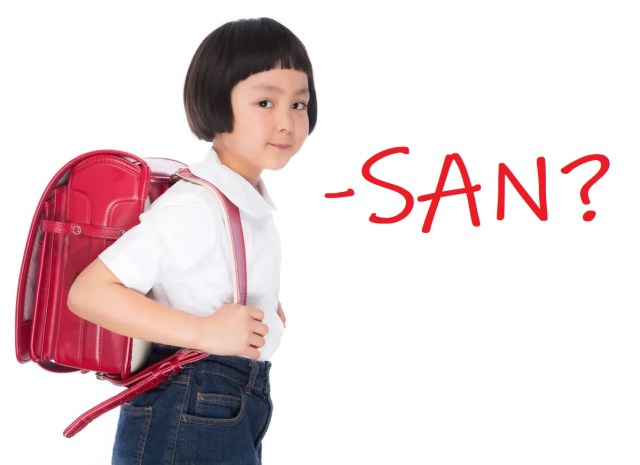
Proper manners, or forcing kids to be too polite?
“-san” is often though of as the Japanese version of “Mr.” or “Ms.” A difference, though, is that -san can also be used with a person’s given name. So, for example, if someone is talking with Yoshio Yamada, they might call him Yamada-san, or they might call him Yoshio-san.
Or they might just call him Yoshio, with no -san at all, or maybe he’s got a nickname, like Yosshi, that people call him by instead.
But at certain elementary schools in Japan, plain Yoshio and Yosshi wouldn’t be options, because some Japanese schools prohibit students from calling each other by nicknames or dropping the -san. There aren’t any official statistics about how widespread such rules are, but one Tokyo public elementary school principal, speaking with the Yomiuri Shimbun newspaper, said he thinks it’s becoming a more common rule at schools in the city.
Tokyo’s Kasai Elementary School, for example, has its teachers instruct students to use -san when talking with their friends. “If you foster a sense of respect for the person they’re talking to from a young age they won’t take actions that hurt others,” says Masaaki Uchino, Kasai Elementary’s 60-year-old principal.
▼ Did this guy spend his formative years not calling his friends with -san?
Advocates of having even children call each other with -san tend to feel that way for two reasons. First, dropping the -san when speaking with someone, a practice called yobisute, can be interpreted in multiple ways. In a positive sense, it can be seen as a sign that there’s no need to stand on stuffy ceremony, and it’s not at all uncommon for especially close friends in Japan to yobisute each other. But on the other hand, since -san is, fundamentally, a polite form of address, dropping it can also be seen as a sign that the person isn’t worthy of respect, especially if the people in the conversation aren’t that close.
Another issue is that, at least among the educators who spoke with Yomiuri Shimbun in favor of mandating the use of -san, there doesn’t seem to be a clear distinction between ordinary nicknames and derogatory ones. “Many nicknames that are based on a person’s physical appearance, or a mistake they made, are insulting,” says Mitsuo Nobuchi, the 51-year-old vice principal at Mito Eiko Elementary, a private school in Ibaraki Prefecture whose conduct rules for students include “Use -san when talking to your friends.” “We don’t believe that rules for how students should address each other will completely stamp out bullying,” admits Nobuchi, “but we do believe it’s a component of deterrent measures.”
However, some believe that forbidding yobisute and nicknames entirely negatively limits their ability to establish their own communication norms with their peers. “By prohibiting nicknames, I worry that they might be making it difficult for children to communicate smoothly and openly with one another,” said a 40-something elementary teacher from Saitama Prefecture. Many Twitter commenters also feel like such rules are going too far, with some citing nicknames as a potentially positive force.
“Such a dumb idea. What’s next? ‘Please call your classmates by their student ID number?’”
“Instead of stopping kids from using nicknames, how about if we stop them from bullying?”
“There are kids who feel embarrassed because their parents gave them a weird, flashy name…but with rules like this, they can’t ask their friends to call them by a nickname instead.”
“There are people whose nickname helped them create an outgoing persona and make friends, and there are people who got saddled with a hurtful nickname they don’t like. It’s pretty complicated.”
“In the third grade, my teacher just had us tell the rest of the class how we wanted them to call us…Worked out great.”
It could be that schools that don’t allow nicknames or yobisute are aware of the benefits that can come from those more casual forms of address, but feel the potential negatives outweigh them. Still, it’d be nice if they could find a way to not throw the baby out with the bathwater, so to speak, in regulating how kids communicate with each other.
Source: Yomiuri Shimbun via Livedoor News, Twitter
Top image: Pakutaso (edited by SoraNews24)
Insert image: Pakutaso
● Want to hear about SoraNews24’s latest articles as soon as they’re published? Follow us on Facebook and Twitter!


 To –san or not to –san? Should you use the Japanese honorific suffix when speaking English?
To –san or not to –san? Should you use the Japanese honorific suffix when speaking English? Some Japanese elementary schools don’t let kids wear underwear during P.E., and parents are mad
Some Japanese elementary schools don’t let kids wear underwear during P.E., and parents are mad Elementary school principal resigns after responding to knife threat with a heavy smack
Elementary school principal resigns after responding to knife threat with a heavy smack Awesome Japanese elementary school teacher rewards kids who use independent learning on his tests
Awesome Japanese elementary school teacher rewards kids who use independent learning on his tests Elementary and junior high students speak out on Japan’s strangest school rules
Elementary and junior high students speak out on Japan’s strangest school rules Top Japanese cosplayer Enako returns to Comiket after 6 years, creates mayhem with admirers
Top Japanese cosplayer Enako returns to Comiket after 6 years, creates mayhem with admirers What makes a good boss in Japan? Workers sound off in survey
What makes a good boss in Japan? Workers sound off in survey Japan’s number-one cosplayer Enako sparks heated debate after revealing insane 2020 income
Japan’s number-one cosplayer Enako sparks heated debate after revealing insane 2020 income Majority of Japanese mayors say foreign residents are essential but most see good and bad effects
Majority of Japanese mayors say foreign residents are essential but most see good and bad effects New Japanese menstrual product seeks to help women spot unidentified iron deficiencies
New Japanese menstrual product seeks to help women spot unidentified iron deficiencies Japan’s first-ever capybara cat cafe opens in Tokyo
Japan’s first-ever capybara cat cafe opens in Tokyo Japanese thug wear from Birth Japan perfect for those breaking bad next year
Japanese thug wear from Birth Japan perfect for those breaking bad next year The Purple Lucky Bag from Village Vanguard is an extra-large waste of money
The Purple Lucky Bag from Village Vanguard is an extra-large waste of money Japanese cat Maru faces biggest dilemma yet: which tiny brown box to sit in
Japanese cat Maru faces biggest dilemma yet: which tiny brown box to sit in Cup Noodle releases new Tomica “car” collection
Cup Noodle releases new Tomica “car” collection Starbucks Japan ready to get Year of the Horse started with adorable drinkware and plushies【Pics】
Starbucks Japan ready to get Year of the Horse started with adorable drinkware and plushies【Pics】 Japanese beef bowl chain Sukiya’s 2026 Smile Box lucky bag basically pays for itself
Japanese beef bowl chain Sukiya’s 2026 Smile Box lucky bag basically pays for itself Hayao Miyazaki says Happy New Year to Studio Ghibli fans with new art for Year of the Horse
Hayao Miyazaki says Happy New Year to Studio Ghibli fans with new art for Year of the Horse Cup Noodle tries an authentic Jiro-style ramen, but something’s not quite right
Cup Noodle tries an authentic Jiro-style ramen, but something’s not quite right The best Starbucks Japan Frappuccinos we want to drink again in 2026
The best Starbucks Japan Frappuccinos we want to drink again in 2026 We revisited Sweets Paradise after a decade to see if Japan’s dessert buffet still delivers
We revisited Sweets Paradise after a decade to see if Japan’s dessert buffet still delivers That time Seiji called JASRAC to ask why he didn’t get paid royalties for his song being on TV
That time Seiji called JASRAC to ask why he didn’t get paid royalties for his song being on TV We found possibly the quietest Japanese-style hotel in Tokyo’s bustling Shinjuku district
We found possibly the quietest Japanese-style hotel in Tokyo’s bustling Shinjuku district Pizza Hut Japan’s hot lucky bags are perfect for a New Year’s pizza party
Pizza Hut Japan’s hot lucky bags are perfect for a New Year’s pizza party Japan’s oldest largetooth sawfish in captivity back on display in Mie Prefecture
Japan’s oldest largetooth sawfish in captivity back on display in Mie Prefecture 7-Eleven Japan starts new temporary luggage storage service in over 300 branches
7-Eleven Japan starts new temporary luggage storage service in over 300 branches Disillusionment at Tsukiji’s tourist-target prices led us to a great ramen restaurant in Tokyo
Disillusionment at Tsukiji’s tourist-target prices led us to a great ramen restaurant in Tokyo Starbucks teams up with 166-year-old Kyoto doll maker for Year of the Horse decorations【Photos】
Starbucks teams up with 166-year-old Kyoto doll maker for Year of the Horse decorations【Photos】 Tokyo considering law requiring more trash cans following litter increase in heavily touristed area
Tokyo considering law requiring more trash cans following litter increase in heavily touristed area Tokyo’s Tsukiji sushi neighborhood asks tour groups to stay away for the rest of the month
Tokyo’s Tsukiji sushi neighborhood asks tour groups to stay away for the rest of the month Tokyo event lets you travel back in time, for free, to celebrate 100 years since Showa era start
Tokyo event lets you travel back in time, for free, to celebrate 100 years since Showa era start Japan may add Japanese language proficiency, lifestyle classes to permanent foreign resident requirements
Japan may add Japanese language proficiency, lifestyle classes to permanent foreign resident requirements Sanrio theme park in Japan announces plans to expand into a Sanrio resort
Sanrio theme park in Japan announces plans to expand into a Sanrio resort Stamina-destroying “Paralysis Noodles” are Tokyo’s newest over-the-top ramen innovation
Stamina-destroying “Paralysis Noodles” are Tokyo’s newest over-the-top ramen innovation Survey asks foreign tourists what bothered them in Japan, more than half gave same answer
Survey asks foreign tourists what bothered them in Japan, more than half gave same answer Japan’s human washing machines will go on sale to general public, demos to be held in Tokyo
Japan’s human washing machines will go on sale to general public, demos to be held in Tokyo Japan’s deadliest food claims more victims, but why do people keep eating it for New Year’s?
Japan’s deadliest food claims more victims, but why do people keep eating it for New Year’s? We deeply regret going into this tunnel on our walk in the mountains of Japan
We deeply regret going into this tunnel on our walk in the mountains of Japan Studio Ghibli releases Kodama forest spirits from Princess Mononoke to light up your home
Studio Ghibli releases Kodama forest spirits from Princess Mononoke to light up your home Major Japanese hotel chain says reservations via overseas booking sites may not be valid
Major Japanese hotel chain says reservations via overseas booking sites may not be valid Put sesame oil in your coffee? Japanese maker says it’s the best way to start your day【Taste test】
Put sesame oil in your coffee? Japanese maker says it’s the best way to start your day【Taste test】 No more using real katana for tourism activities, Japan’s National Police Agency says
No more using real katana for tourism activities, Japan’s National Police Agency says Starbucks Japan reveals new sakura drinkware collection, inspired by evening cherry blossoms
Starbucks Japan reveals new sakura drinkware collection, inspired by evening cherry blossoms Updated cherry blossom forecast shows extra-long sakura season for Japan this year
Updated cherry blossom forecast shows extra-long sakura season for Japan this year Japanese high schools abolish old rules, provide freedom with underwear, hair and dating
Japanese high schools abolish old rules, provide freedom with underwear, hair and dating Do Japanese kids need to wear special slippers at school? One part of Tokyo doesn’t think so
Do Japanese kids need to wear special slippers at school? One part of Tokyo doesn’t think so This six-year-old Japanese girl is school’s one and only first-grader as lack-of-kids shutdown ends
This six-year-old Japanese girl is school’s one and only first-grader as lack-of-kids shutdown ends The Japanese language has a special honorific suffix just for talking to athletes
The Japanese language has a special honorific suffix just for talking to athletes Blackboards in the west, hallways in the north: Japanese school layouts spark discussion online
Blackboards in the west, hallways in the north: Japanese school layouts spark discussion online Record number of foreign children in Japan need help understanding Japanese in school
Record number of foreign children in Japan need help understanding Japanese in school Why do kids in Japan use those large leathery “randoseru” school bags?
Why do kids in Japan use those large leathery “randoseru” school bags? Japanese middle school promotes long pants to full-uniform status for girls, equal with skirts
Japanese middle school promotes long pants to full-uniform status for girls, equal with skirts Japanese public school to allow male students to wear skirts, chest ribbons as part of uniform
Japanese public school to allow male students to wear skirts, chest ribbons as part of uniform Students confused over Japanese school banning ponytails for “conjuring lustful feelings”
Students confused over Japanese school banning ponytails for “conjuring lustful feelings” Teachers reprimanded for using Japanese imperial flag and apparent war propaganda on school test
Teachers reprimanded for using Japanese imperial flag and apparent war propaganda on school test Niigata school superintendent resigns over improper use of Japanese word for “you”
Niigata school superintendent resigns over improper use of Japanese word for “you” Japanese elementary schools’ list of behavior requirements would be hard for most adults to clear
Japanese elementary schools’ list of behavior requirements would be hard for most adults to clear Japanese high school ends tradition of having all students walk 85-kilometer all-night trek
Japanese high school ends tradition of having all students walk 85-kilometer all-night trek
Leave a Reply